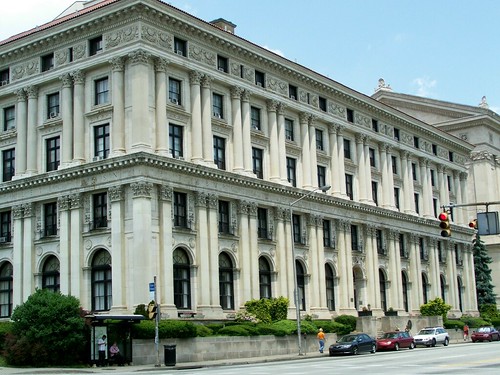At the turn of the 20th century, what would become the Oakland section of Pittsburgh was mostly open fields. Andrew Carnegie had built his library and museums there, which inspired a grand vision in a real estate developer named Franklin Nicola.
With the City Beautful movement as an additional inspiration, Nicola envisioned a civic center that would house cultural instutions and progressive housing in a much more pleasant atmosphere than that offered by the smoky city a few miles to the west.
Nicola sold his idea to such shrewd businessmen as Carnegie, Henry Clay Frick, H.J. Heinz and Andrew Mellon, who backed his venture. After buying land from Mary Schenley, who inherited vast tracts of property in the Pittsburgh area, he began to make his vision a reality.
Over time, the University of Pittsburgh, Carnegie Tech (now Carnegie Mellon University), a world-class hotel and a fine housing development -- Schenley Farms -- grew in the area.
Nicola also saw the need for a place where "a sound mind in the sound body" could be developed. Again, he reached out to Pittsburgh's business community and found a receptive audience. This led to the formation of the Pittsburgh Athletic Association in 1908.
To house the new club, Nicola turned to architect Benno Janssen, who based the resulting structure pictured above on a Venetian palace. When completed in 1911, it featured a third-floor pool, running track, bowling lanes and a room for fine dining.
The PAA, which is still going strong more than 100 years later, was listed on the National Register of Historic Places in 1978.
For more, visit www.paaclub.com/club/scripts/public/public.asp?GRP=12014&...
Monday, June 20, 2011
Pittsburgh Athletic Association
Subscribe to:
Post Comments (Atom)



1 comment:
vans shoes, nfl jerseys, wedding dresses, ghd, celine handbags, longchamp, ugg boots, abercrombie and fitch, lululemon outlet, uggs outlet, herve leger, ugg pas cher, chi flat iron, ugg australia, north face outlet, canada goose, north face jackets, mont blanc, giuseppe zanotti, canada goose jackets, beats by dre, ugg, mcm handbags, valentino shoes, new balance shoes, instyler, soccer shoes, babyliss pro, ferragamo shoes, mac cosmetics, rolex watches, insanity workout, p90x, bottega veneta, jimmy choo outlet, canada goose uk, canada goose, nike huarache, canada goose outlet, canada goose, reebok outlet, ugg boots, soccer jerseys, hollister, asics running shoes, birkin bag, marc jacobs, nike roshe run
Post a Comment